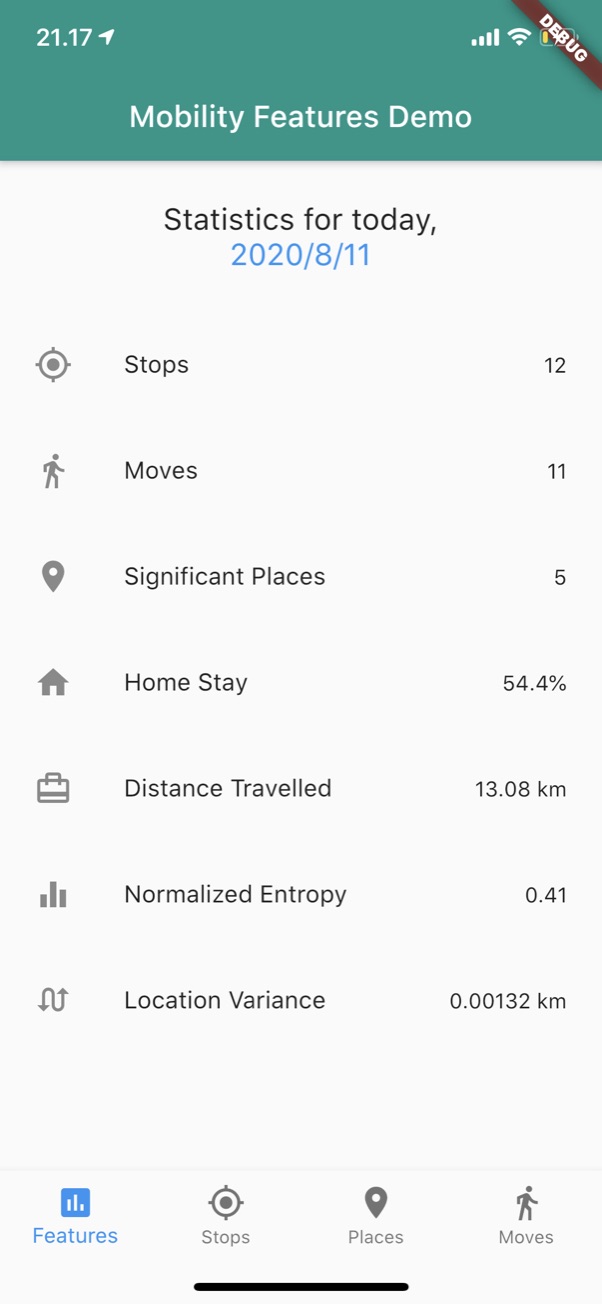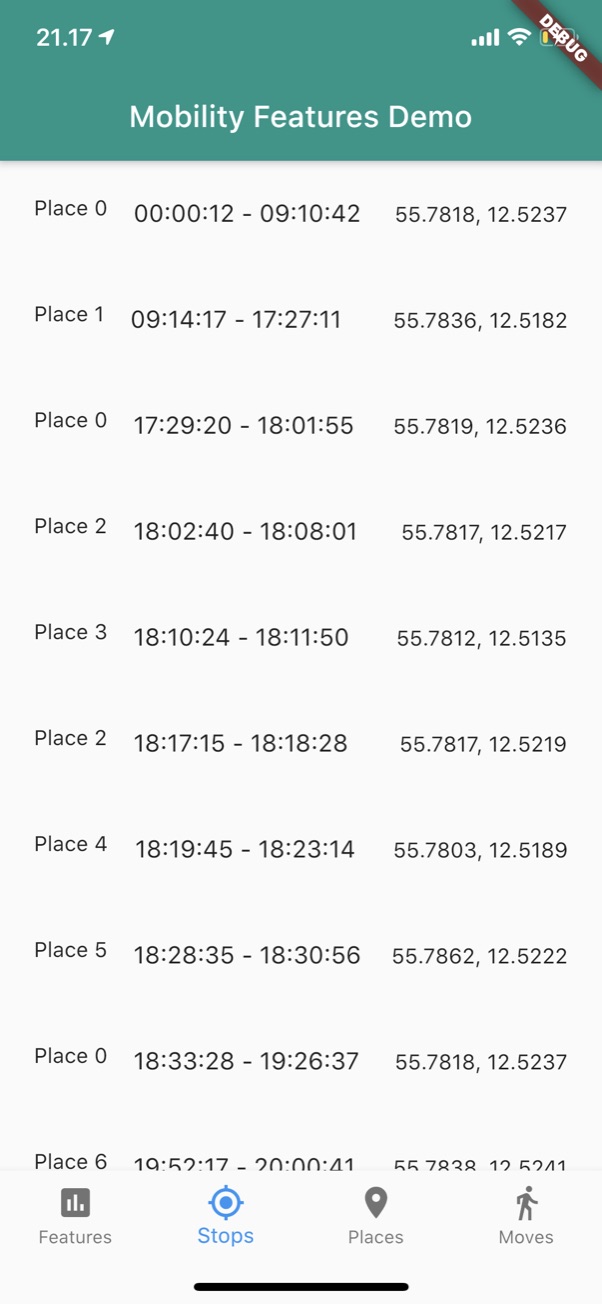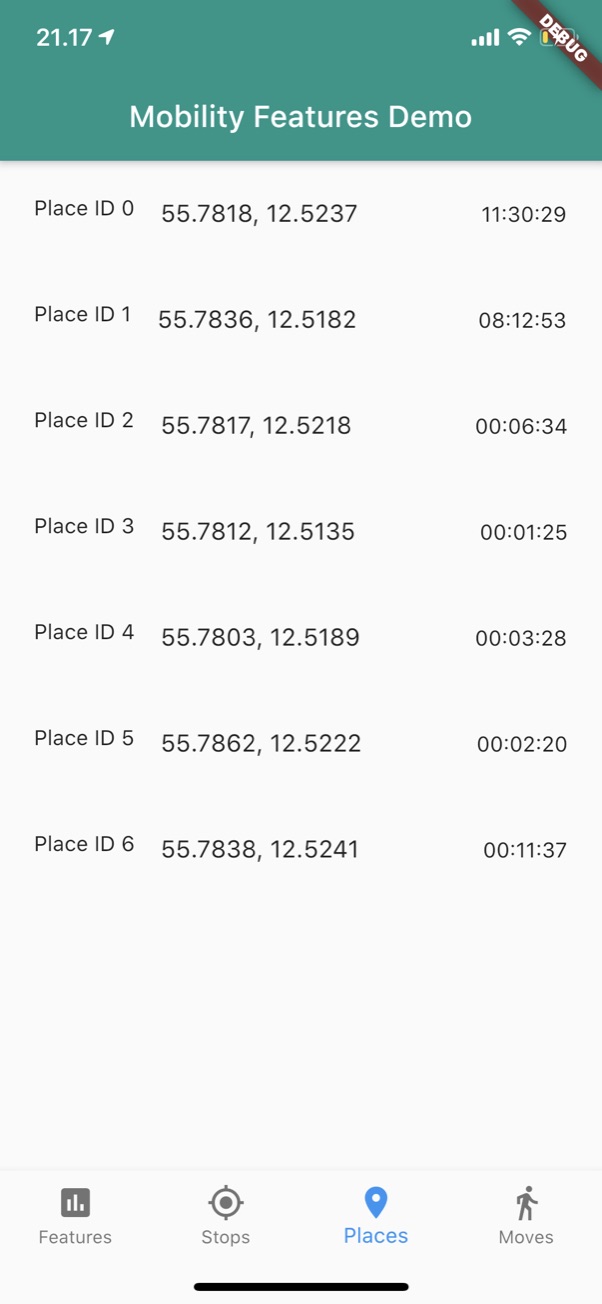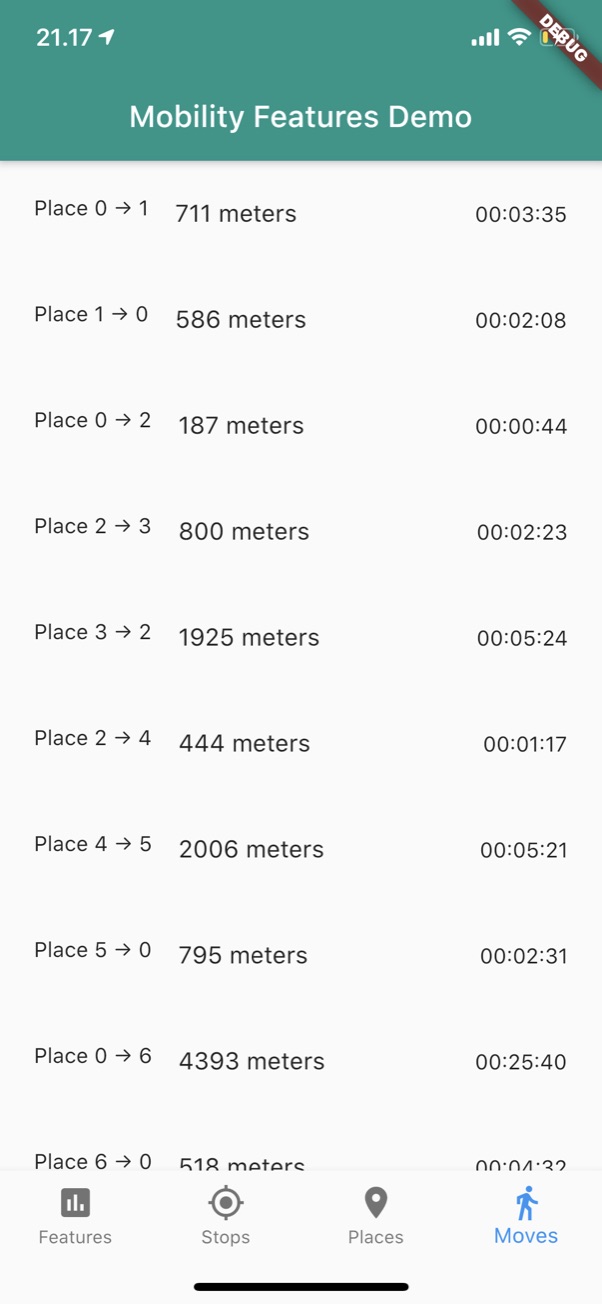The Mobility Features package is designed to work independent of the location plugin. You may choose you own location plugin, since you may already use this in your app.
In the example app we use our own plugin carp_background_location which works on both Android and iOS as of August 2020. However, the
location plugin will also work. The important thing, however, is to make sure that the app runs in the backgound. On Android this is tied to running the app as a foregound service.
Add the package to your pubspec.yaml file and import the package
import 'package:mobility_features/mobility_features.dart';The plugin works as a singleton and can be accessed using MobilityFeatures() in the code.
The following configurations can be made, which will influence the algorithms for producing features:
- The stop radius should be kept low (5-20 meters)
- The place radius somewhat higher (25-50 meters).
- The stop duration can also be set to any desired duration, for most cases it should be kept lower than 3 minutes.
Configuration is done like shown below:
StreamSubscription<MobilityContext> mobilitySubscription;
MobilityContext _mobilityContext;
void initState() {
...
MobilityFeatures().stopDuration = Duration(seconds: 20);
MobilityFeatures().placeRadius = 50;
MobilityFeatures().stopRadius = 5.0;
}Features computation is triggered when the user moves around and change their geo-position by a certain distance (stop distance). If the stop was long enough (stop duration) the stop will be saved. Places are computed by grouping stops based on distance between them (place radius)
Common for these parameters is that their value depend on what you are trying to capture. Low parameter values will make the features more fine-grained but will trigger computation more often and will likely also lead to noisy features. For example, given a low stop duration, stopping for a red light in traffic will count as a stop. Such granularity will be irrelevant for many use cases, but may be useful if questions such as "Do a user take the same route to work every day?"
Collection of location data is not directly supported by this package, for this you have to use a location plugin such as carp_background_location. You can to convert from whichever location object is used by the location plugin to a LocationSample object.
Next, you can start listening to location updates and subscribe to the MobilityFeatures()'s contextStream to be be notified each time a new set of features has been computed.
Below is shown an example using the carp_background_location plugin, where a LocationDto stream is converted into a LocationSample stream by using a map-function.
/// Set up streams:
/// * Location streaming to MobilityContext
/// * Subscribe to MobilityContext updates
void streamInit() async {
locationStream = LocationManager().locationStream;
// subscribe to location stream - in case this is needed in the app
if (locationSubscription != null) locationSubscription.cancel();
locationSubscription = locationStream.listen(onLocationUpdate);
// start the location service (specific to carp_background_location)
await LocationManager().start();
// map from [LocationDto] to [LocationSample]
Stream<LocationSample> locationSampleStream = locationStream.map(
(location) => LocationSample(
GeoLocation(location.latitude, location.longitude),
DateTime.now()));
// provide the [MobilityFeatures] instance with the LocationSample stream
MobilityFeatures().startListening(locationSampleStream);
// start listening to incoming MobilityContext objects
mobilitySubscription =
MobilityFeatures().contextStream.listen(onMobilityContext);
}
/// Called whenever location changes.
void onLocationUpdate(LocationDto dto) {
print(dtoToString(dto));
}A call-back method is used to handle incoming MobilityContext objects:
/// Handle incoming contexts
void onMobilityContext(MobilityContext context) {
/// Do something with the context
print('Context received: ${context.toJson()}');
}All features are implemented as getters for a MobilityContext object.
/// Location features
context.places;
context.stops;
context.moves;
/// Derived features
context.numberOfSignificantPlaces;
context.homeStay;
context.entropy;
context.normalizedEntropy;
context.distanceTravelled;The example application included in the package shows the feature values, including separate pages for stops, moves and places.
When a feature cannot be evaluated, it will result in a value of -1.0.
Examples:
- The Home Stay feature requires at least some data to be collected between 00:00 and 06:00 otherwise the feature cannot be evaluated.
- The Entropy and Normalized Entropy features require at least 2 places to be evaluated. If only a single place was found, this will result in an Entropy of 0.
For mental health research, location data, together with a time component, both collected from the user’s smartphone, can be reduced to certain behavioral features pertaining to the user’s mobility. These features can be used to diagnose patients suffering from mental disorders such as depression.
The mobility features which will be used are derived from GPS location data are:
-
Stop: A collection of GPS points which together represent a visit at a known
Place(see below) for an extended period of time. AStopis defined by a location that represents the centroid of a collection of data points, from which a is created. In addition aStopalso has anarrivaland adeparturetime-stamp, representing when the user arrived at the place and when the user left the place. From the arrival- and departure timestamps of the Stop the duration can be computed. -
Place: A group of stops that were clustered by the DBSCAN algorithm. From the cluster of stops, the centroid of the stops can be found, i.e. the center location. In addition, it can be computed how long a user has visited a given place by summing over the duration of all the stops at that place.
-
Move: The travel between two Stops, which the user will pass though a path of GPS points. The distance of a Move can be computed as the sum of using the haversine distance of this path. Given the distance travelled as well as departure and arrival timestamp from the Stops, the average speed at which the user traveled can be derived.
-
Home Stay: The portion (percentage) of the total time elapsed since midnight which was spent at home. Elapsed time is calculated from the departure time of the last known stop.
-
Location Variance: The statistical variance in the latitude- and longitudinal coordinates.
-
Number of Places: The number of places visited today.
-
Entropy: The entropy with respect to time spent at places.
-
Normalized Entropy: The normalized entropy with respect to time spent at places.
-
Distance Travelled: The total distance travelled today (in meters), i.e. not limited to walking or running.
Author: Thomas Nilsson ([email protected])



